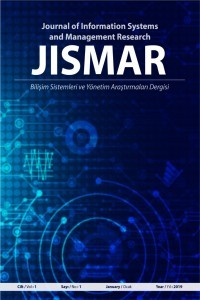Sadakat Programında Müşteri Kayıp Tahmini: Bir Vaka Çalışması
Müşteri Kayıp Tahmini, Sadakat Programı, Lojistik Regresyon, Yapay Sinir Ağları
___
- 1] Dixon, M. “39 Experts predict the future.” America’s Community Banker, vol 8(7), pp. 20–31, 1999
- [2] Floyd, T. “Creating a New Customer Experience”. Bank Systems and Technology, vol 37(1), R8–R13, 2000
- [3] Slater, Stanley & Narver, John. “Intelligence and Superior Customer Value.” Journal of the Academy of Marketing Science, ol 28, pp. 120-127, 2012 Doi: 10.1177/0092070300281011.
- [4] Ling, R., & Yen, D.C. “Customer relationship management: An analysis framework and implementation strategies”. Journal of Computer Information Systems, vol 41(3), pp. 82–97, 2001
- [5] Berson, Alex, Stephen Smith, and Kurt Thearling. Building Data Mining Applications for CRM. London: McGraw-Hill, 2000.
- [6] Glady, Nicolas & Baesens, Bart & Croux, Christophe. “Modeling Churn Using Customer Lifetime Value”. European Journal of Operational Research, vol 197, pp. 402-411, 2009 Doi: 10.1016/j.ejor.2008.06.027.
- [7] Van den Poel, Dirk & Lariviere, Bart. “Customer Attrition Analysis for Financial Services Using Proportional Hazard Models”. European Journal of Operational Research, vol 157, pp. 196-217, 2004 Doi: 10.1016/S0377-2217(03)00069-9.
- [8] Buckinx W. and Van den Poel, D. “Customer base analysis: Partial defection of behaviourally loyal clients in a non-contractual FMCG retail setting.” European Journal of Operational Research, vol 164, pp. 252-268, July 2005 Doi: 10.1016/j.ejor.2003.12.010.
- [9] Tamaddoni, Ali & Sepehri, Mohammad & Teimourpour, Babak & Choobdar, Sarvenaz. “Modeling customer churn in a non-contractual setting: The case of telecommunications service providers”. Journal of Strategic Marketing, vol 18, pp. 587-598, 2010. Doi: 10.1080/0965254X.2010.529158.
- [10] Nie, Guangli & Rowe, Wei & Zhang, Lingling & Tian, Yingjie & Shi, Yong. “Credit card churn forecasting by logistic regression and decision tree”. Expert Syst. Appl., vol 38, pp. 15273-15285, 2011 Doi: 10.1016/j.eswa.2011.06.028.
- [11] Dreiseitl, Stephan & Ohno-Machado, Lucila. Logistic regression and artificial neural network classification models: A methodology review. Journal of biomedical informatics, vol 35(5-6), pp. 352-359, 2002, Doi: 10.1016/S1532-0464(03)00034-0.
- [12] L. Atlas et al., "A performance comparison of trained multilayer perceptrons and trained classification trees," Conference Proceedings., IEEE International Conference on Systems, Man and Cybernetics, Cambridge, MA, USA, 1989, pp. 915-920 vol.3.
- [13] Brown, Donald E., Vincent Corruble and Clarence Louis Pittard. “A comparison of decision tree classifiers with backpropagation neural networks for multimodal classification problems.” Pattern Recognition, vol 26, pp. 953-961, 1992 Doi: 10.1016/0031-3203(93)90060-A
- [14] Linder, Roland & Geier, Jeannine & Kölliker, Mathias. “Artificial neural networks, classification trees and regression: Which method for which customer base?”. The Journal of Database Marketing & Customer Strategy Management, vol 11, pp. 344-356, 2003 Doi: 10.1057/palgrave.dbm.3240233.
- [15] Khan, A.A & Jamwal, Sanjay & Sepehri, Mohammad Mehdi. “Applying Data Mining to Customer Churn Prediction in an Internet Service Provider”. International Journal of Computer Applications, vol 9(7), pp. 8-14, 2010 Doi: 10.5120/1400-1889.
- [16] Hwang, Hyunseok & Jung, Taesoo & Suh, Euiho. “An LTV model and customer segmentation based on customer value: A case study on the wireless telecommunication industry”. Expert Systems with Applications, vol 26, pp. 181-188, 2004 Doi: 10.1016/S0957-4174(03)00133-7.
- [17] Hosmer, David W., Stanley Lemeshow, and Rodney X. Sturdivant. Applied Logistic Regression. 3rd ed. Hoboken, NJ: Wiley, 2013.
- ISSN: 2717-9931
- Yayın Aralığı: Yılda 2 Sayı
- Başlangıç: 2019
- Yayıncı: M. Hanefi CALP
Blockchain Tabanlı Bir Veri Yönetim Modeli
Mohammed ALSADİ, Sevinç GÜLSEÇEN, Sinan KARA, Büşra ÖZDENİZCİ KÖSE, Vedat COŞKUN
Sadakat Programında Müşteri Kayıp Tahmini: Bir Vaka Çalışması
Yeşim KOCA, Burak Emre SÖĞÜT, Sona MARDİKYAN
Yapay Zeka ile Siber Zorbalık Eğiliminin Belirlenmesi
Yeni Dünya Düzeninde Öğrenen Örgütler, Değişim ve İnovasyon Yönetimi
Ders Programı Çizelgeleme Probleminin Genetik Algoritma ile Optimizasyonu
Makine Öğrenmesinde Yeni Bir Bakış Açısı: Otomatik Makine Öğrenmesi (AutoML)
Smart City Applications In Digital Age: State-Of-Art Review and Critique
Yapay Zekâ Yöntemlerinde Entropi
Muhammed Ali KOŞAN, Aysun COŞKUN, Hacer KARACAN
Yazılım Hata Kestirimine Nesne Yönelimli Ölçütlerin Etkisi
Tülin ERÇELEBİ AYYILDIZ, Begüm ERKAL
